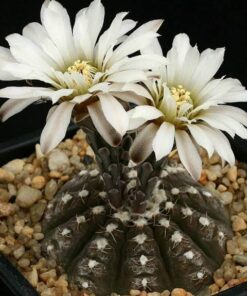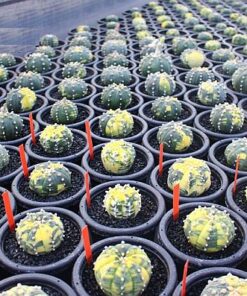Ariocarpus Kotschoubeyanus v. elephantidens Pack of 5 seeds
₹249.00
Out of stock
Email when stock available
Ariocarpus Kotschoubeyanus v. elephantidens Scientific name: Ariocarpus kotschoubeyanus Schumann K.
In: Engler, Bot. Jahrb. 24:544. 1898
Conservation status: Listed in CITES appendix I
Ariocarpus Kotschoubeyanus v. elephantidens Synonyms:
- Ariocarpus sulcatus Schumann K. (1894) in Engler & Prantl,
In: Nat. Pflanzenfam. 3, 6a:195 - Roseocactus kotschoubeyanus (Lemaire) A. Berger
Origin: Mexico, This species is widely distributed as a large number of small, isolated populations in a big area extending over 600 km, from central Coahuila in the north to Queretaro in the south, and the species is also found in the states of Zacatecas, San Luis Potosi, Nuevo Leon and Tamaulipas.
Description: A. kotschoubeyanus are very flat geophyte cactus that produce small star-shaped rosettes. They in most cases don’t reach more than only a few centimetres above the ground. Although they can form clumps, often only a small disc of tubercles can be seen flat at the soil surface, however these plants grow a large tap root below the surface of the compost.
Stem: Usually solitary, rarely giving rise to side shoots from old areoles, flattened on top, depressed centrally.
Tubercles: The tubercles are deltoid dark olive green with no spines and lie flat on the soil surface. They are more long than wide, closely packed and divergent, sharply angled apically.
Areoles: The tubecles forms a central longitudinal areolar groove extending to the tips on the adaxial surfaces of the tubercles, woolly, 1-3 mm wide, 5-10 mm long.
Root: Each plant has a large turnip-like taproot, which lies below the soil surface and serves for water storage.
Flowers: These plants have a woolly crown, from which emerge bright pink-violet flowers up to 2.5-5 cm, 2 times wider than long when fully expanded. Flowers are diurnal and last for 3 to 4 days. The white-flowered variety was described as var. albiflorus.
Blooming time: Mid-September onwards.
Fruits: White or green with lots of seed.
Be the first to review “Ariocarpus Kotschoubeyanus v. elephantidens Pack of 5 seeds” Cancel reply
You must be logged in to post a review.
Related products
cactus and succulent seeds
cactus and succulent seeds
Gymnocalycium mihanovichii seeds Variegated Seeds pack of 15-20 seeds
cactus and succulent seeds
cactus and succulent seeds












Reviews
There are no reviews yet.